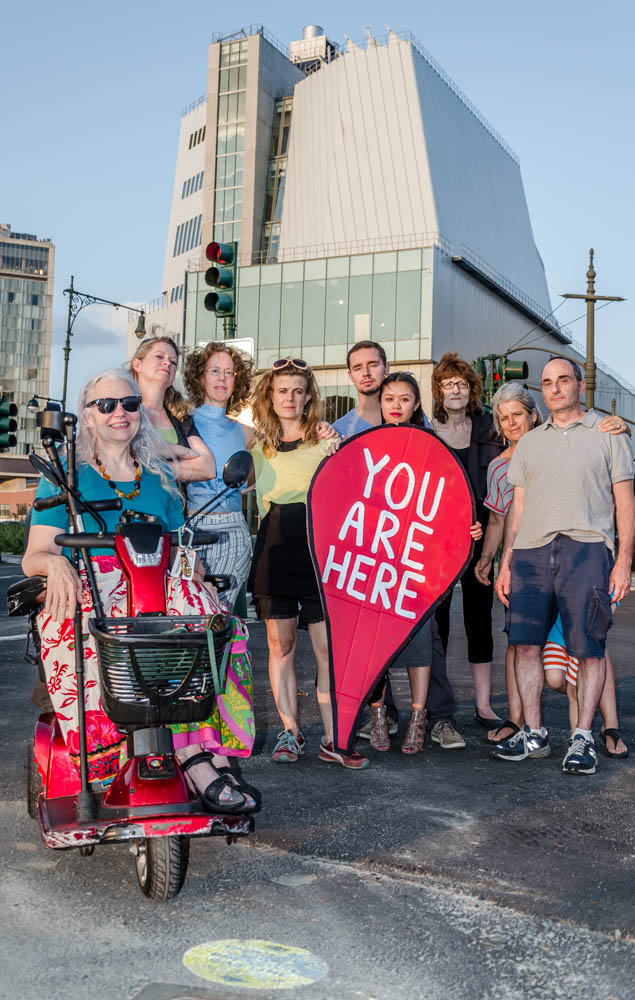 On March 12, The Villager published an account that detailed some of the concerns raised about the imminent opening of the new Whitney Museum, which sits directly above the Spectra pipeline. Sane Energy's response to the article refutes Spectra spokesperson Marylee Hanley's by-now-tired line about Spectra being built to "meet or exceed federal regulations," explaining exactly how lax those regulations are. Our letter to the editor was published one week before the East Village gas explosion, an accident whose scale would be much greater if it happened with a pipeline the size and pressure of Spectra's.
On March 12, The Villager published an account that detailed some of the concerns raised about the imminent opening of the new Whitney Museum, which sits directly above the Spectra pipeline. Sane Energy's response to the article refutes Spectra spokesperson Marylee Hanley's by-now-tired line about Spectra being built to "meet or exceed federal regulations," explaining exactly how lax those regulations are. Our letter to the editor was published one week before the East Village gas explosion, an accident whose scale would be much greater if it happened with a pipeline the size and pressure of Spectra's.
Above, the Sane Energy team at the site of the Spectra pipeline, with the new Whitney museum in the background, just across the West Side Highway in Manhattan.
To The Editor:
Re “Gas pipeline protests no longer burn, but could problems flare in future?”
Thank you, Ms. Stukane and The Villager for steadfastly following the story of the Spectra pipeline from the early moments of the review process through now, when the Whitney Museum is about to open on top of it.
We are eager when any new showcase for art opens, and support the cultural and economic boost the Whitney will bring to the West Village; and we are cognizant of the lack of real estate to build museums in Manhattan.
However, the choice to site anything so close to the Spectra pipeline is a choice we find utterly lacking in judgment. We wonder how this decision came to be.
Building the Whitney on top of the pipeline puts visitors, workers and irreplaceable art, not to mention a Renzo Piano creation, at risk. The museum’s spokesperson appears to express no worry, saying that the art will be stored five stories above the pipeline and that they are “trusting that the appropriate government agencies will stay on top of it.” Such trust is misplaced.
In the event of an explosion at the site of the vault, a crater at least the size of the museum itself is likely, and would affect an area about a block and a half in radius; with smoke, broken glass, closed streets and secondary fires affecting a much larger radius.
When a pipeline of similar size and pressure exploded in San Bruno, California, in 2010, it blew a crater four stories deep, and destroyed 38 suburban houses. Being five stories higher will do little to save the art or anyone viewing it. One wonders if the museum is adequately insured.
As for protection from the agencies charged with oversight, the federal regulations that Spectra’s spokesperson, Ms. Hanley, is so fond of referring to require internal inspection for corrosion only once every seven years. The 24-hour monitoring she refers to is done by remote computers in Texas. Such remote monitoring has been shown to fail on many occasions.
Secondary monitoring may be done by someone walking the route of the pipeline looking for dead grass or plants. (Gas leaks kill the roots of plants.) One may notice that most of the area stretching from Gansevoort Peninsula to the Whitney consists of the West Side Highway and sidewalks. In other words, it’s paved.
The Whitney is hardly the only institution that looked at the risks of the pipeline and shrugged. There are many businesses in close proximity to the route of the pipeline, including the Standard Hotel. The Friends of the High Line declined to take a stance against it when the pipeline was under review. One wonders what motivated them to put their own interests at risk the way they did.
In fairness, shouldn’t businesses and institutions be able to trust when regulatory agencies declare a project safe? The reality is they can’t, and they shouldn’t. The reality is that such agencies review projects with the interests of corporations in mind, not the interests of the public.
The Hudson River Park Trust, under the leadership of then-Mayor Bloomberg’s companion, Diana Taylor, saw to it that the easement for the pipeline was approved in a disgraceful display of influence over intelligence and for a pittance.
Bloomberg, with close ties to fracking founder George Mitchell, wanted the city to convert to shale gas and made sure this pipeline was built, over the objections of thousands of New Yorkers.
The Federal Energy Regulatory Commission, the agency that approves (and they always approve) pipeline projects, reviewed an environmental impact statement that was paid for by Spectra Energy. FERC declared, in the final environmental impact statement that not to approve the pipeline was impossible because to do so “would not meet the needs of the Applicant” (Spectra).
I am quoted as saying, “At this point, there isn’t anything more we [Sane Energy Project] can do,” as far as legal action to stop Spectra from operating this particular pipeline. However, there is plenty we can do — and continue to do — to educate the public and elected officials about the dangers and climate impact of pipelines and the use of shale (“natural”) gas, which contributes to climate change and sea level rise with an effect that is 86 times worse than carbon dioxide.
Sane Energy Project and our many allies continue to advocate for the city to halt the building of any additional fossil fuel infrastructure, and advocate for this city to build only renewable-energy infrastructure. We continue to advocate for an energy system that is democratically decided and takes the public’s input seriously. We remain hopeful that Mayor De Blasio is truly committed to his “80 by 50 plan” — to reduce emissions by 80 percent by 2050 — and that he will discontinue the shale gas build-out that his Republican predecessor began.
– Clare Donohue
Program Director, Sane Energy Project
 On March 12, The Villager published an account that detailed some of the concerns raised about the imminent opening of the new Whitney Museum, which sits directly above the Spectra pipeline. Sane Energy's response to the article refutes Spectra spokesperson Marylee Hanley's by-now-tired line about Spectra being built to "meet or exceed federal regulations," explaining exactly how lax those regulations are. Our letter to the editor was published one week before the East Village gas explosion, an accident whose scale would be much greater if it happened with a pipeline the size and pressure of Spectra's.
On March 12, The Villager published an account that detailed some of the concerns raised about the imminent opening of the new Whitney Museum, which sits directly above the Spectra pipeline. Sane Energy's response to the article refutes Spectra spokesperson Marylee Hanley's by-now-tired line about Spectra being built to "meet or exceed federal regulations," explaining exactly how lax those regulations are. Our letter to the editor was published one week before the East Village gas explosion, an accident whose scale would be much greater if it happened with a pipeline the size and pressure of Spectra's.